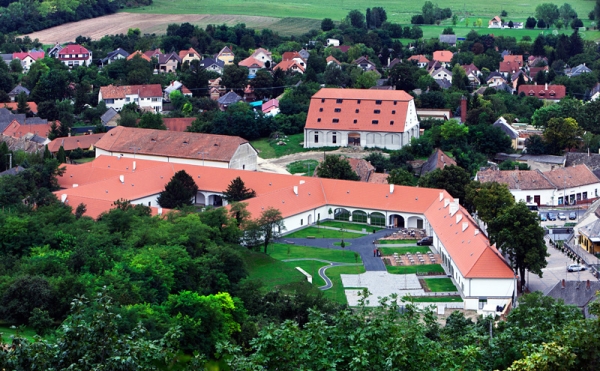Succisa virescit
The Manor of the Abbey and its Visitors’ Center, Pannonhalma
Architects: Tamás Czigány, Róbert Papp
Text: Dominika Vámos
Photos: Tamás Bujnovszky

Built in the mid-18th century under the personal supervision of Benedek Sajghó Arch-Abbot who had been legendarily strict, the manor evolved into the economic centre of the former „sustainable” abbey. Thanks to him, the site belonging to the abbey of Pannonhalma has been restored to its significance in line with its historical role after being seriously damaged during the Turkish occupation. The revival of Pannonhalma in the 21st century has arrived at yet another milestone: the former manor of the abbey has been converted into a visitors’ centre after plans by Czita Architects, a regular contributor to architectural projects in Pannonhalma, namely by Tamás Czigány and Róbert Papp.
However, because of its role and geographical position, the manor does not physically belong to the abbey and as such it, now plays an even more important role in the rehabilitation of the long-wished-for live relationship between St. Martin’s Hill and Győrszentmárton (today the town of Pannonhalma, formerly a village) which spreads at its foot. Articulated by closed-opened yards the house actually stands in the heart of the village, surrounded by other farm buildings, and yet forms a kind of peculiar island. Its closed configuration is only opened on one side facing St. Martin’s Hill in a spectacular and fascinating way. From the very beginnings, the monastery and the village had been closely associated with each other in a genuine feudal hierarchy, which is still reflected by the steep and narrow lanes flanked by tiny houses that nestle up to the magnificently outstanding centre of the abbey surrounded with battlements. Beyond doubt, the Abbey is the landmark of the landscape and thus defines time, orientation, scale and height.
Monks and friars living in Pannonhalma – faithfully to the dwellers of Montecassino which is the first monastery of the Benedictine order – who had witnessed and survived several disastrous events of history themselves. „Succisa virescit” („having been cut down, it flourishes again”) – the motto of the Benedictine order appears ever so relevant in a Hungarian context where the destiny of the monastery of Pannonhalma symbolically conveyed and bore the cataclysms, calamities and rebirths of the national history. Once flourishing, the manor has survived several transformations of various scales during its 250 years of existence, including the cruel interventions after 1945 following a „change of ownership”, as even during the decades of agricultural co-operatives it was primarily used as a winery. However, it had almost met its fate during the period of privatisation after the change of the political system when it hardly had any proper owners.
The most recent era of its revival is associated with the name of Arch-Abbot Asztrik Várszegi is based on a development strategy which had been planned with unique awareness unparalleled in the history of Pannonhalma. It is focussed on EU projects which have a unique logic of their own but may be tapped quite effectively with the necessary craft. Those who have heard a lecture by Father Cirill Hortobágyi concerning the revival concept of the Abbey which tends to be maintained more and more like a large-scale plant, will have no doubt about its material growth which is not meant for profiting for its own sake, but to restore the highly sensitive balance of the soul, spirit and economy which has been lost meanwhile. The complex of the former manor of the abbey has been repurchased now to meet the needs of tourism and tourist accommodation which has been rather poor so far.
As it happened, a tender was published recently for a visitors’ centre and the utilization of renewing energies, which entailed the modification of the scheme accordingly. The network of underground cellars ca. 400 m long and the single-storey brick-vaulted building which had housed stables, sheds and workshops – arranged around a a four-fold courtyard complex according to an interesting spatial dramaturgy – are going to house various exhibitions as well as a confectionery, souvenir shop and multi-functional social hall. The heating system of this new institution is meant to rely upon geothermal probes.
Construction projects in Pannonhalma show the tendency to correct and unambiguous concepts compared to the usually ambitious and daring ones featuring architecture. This well-balanced and yet firm approach is actually a brandmark of Tamás Czigány concerning his entire oeuvre, and especially his works in Pannonhalma. His young fellow architects have proven to be talented partners in doing so. The success of the manor building as well as its beauty and goodness, however, also presupposes live nexus based on mutual trust which is almost unique in Hungary concerning the processes preceding decision-making and designing concepts, the approach, financial and marginal conditions alike.
Architecture: Tamás Czigány, Róbert Papp, András Cseh – CZITA Építész Iroda Kft.
Interiors: Györgyi Tóth – Czita Építész Iroda Kft.
Structure: István Serfőző – LMS-Terv Mérnöki Iroda Kft.
HVAC: István Kovács, Tibor Gaál – KondiCAD Mérnökiroda Kft.
Electrical engineering: Rezső Luksander – KondiVILL Kft.
Lighting: Ferenc Haász – ERCO Lighting
Public utilities: Gyula Tóth – Viadukt Kft.
Roads: Tamás Kovács Jr. – Viadukt Kft.
Environment: Helga Hencz – Kertművek Kft.
Main contractor: LAKI Épületszobrász Zrt.
Project management: Emese Lakatosné Hőhn, Zsolt Király
Furniture: Pápai Asztalos Kft.
Client: Magyar Bencés Kongregáció Pannonhalmi Főapátság










